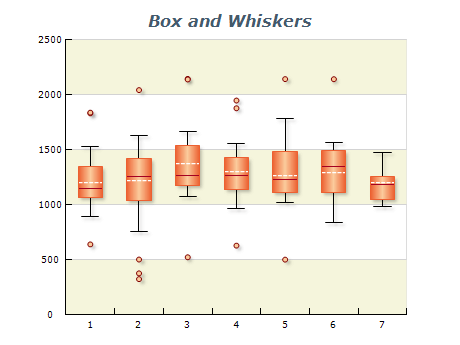| | |
 | A box and whiskers chart is a powerful type that provides a quick and easy summary of a dataset's overall data distribution. It presents the data in the form of a box and whiskers series, which enables the viewer to see the data's range, median, quartiles, and outliers at a glance. This makes it an excellent tool for identifying patterns and trends in the data and detecting any anomalies or outliers that may be present. With its ability to convey complex information clearly and concisely, a box and whiskers chart is a valuable resource for making informed decisions based on data. |
|
|
![date time box and whiskers chart]() | A date-time box and whiskers chart is a powerful visualization tool that allows you to compare the statistical parameters of several datasets produced at different times. When working with time-based data, a date-time box and whiskers chart is an excellent tool for quickly identifying patterns and trends in your data.
This chart's box and whiskers series uses custom date-time values and provides a clear and concise summary of the data distribution. Each box and whiskers item represents a set of values. It displays important statistical information, such as the minimum, maximum, and median values, upper and lower quartiles, and any outliers that may be present. Additionally, you can choose to display the average value as well. With its ability to convey complex information in an easy-to-understand format, a date-time box and whiskers chart is invaluable for anyone looking to gain insights from their data. Whether you're analyzing sales data, financial performance, or any other time-based metrics, this chart can help you make informed decisions based on your data. |
|
|
![box and whiskers data distribution]() | A data distribution chart is an effective way to summarize the overall distribution of data in a dataset. This chart type uses a box and whiskers series to display statistical information such as the minimum, maximum, and median values, upper and lower quartiles, and any outliers that may be present. With its ability to convey complex information clearly and concisely, a data distribution chart is a valuable resource for anyone looking to make data-driven decisions based on their data. |
|
| |
A Box and Whisker chart, or a Box plot, is a powerful chart for visualizing statistical data. It displays the distribution of a dataset using quartiles and outliers,
allowing users to quickly identify patterns and trends. The chart consists of a box representing the middle 50% of the data, with a line inside indicating the median value.
The chart displays the minimum and maximum values as whiskers that extend from the box, and any outliers are represented as individual data points beyond the whiskers.
Furthermore, it is highly customizable with options to adjust colors and labeling, making it an effective tool for data analysis.
|
| Sample Name | Minimum | Lower Quartile | Median | Upper Quartile | Maximum |
|---|
| Sample A | 5 | 8 | 10 | 15 | 20 | | Sample B | 10 | 12 | 15 | 18 | 25 | | Sample C | 8 | 10 | 12 | 16 | 22 |
This table represents three different samples of numerical data, each with five statistical measures. The minimum and maximum values indicate the range of values in each sample, while the lower and upper quartiles represent the 25th and 75th percentiles, respectively. The median is the value that divides the data into two halves.
Comparing the values across the samples, we can observe differences in their distributions, ranges, and central tendencies. The box and whisker chart is a valuable tool to visually compare these characteristics and identify any outliers or unusual patterns in the data.
|
- Use Box and Whiskers charts to compare data: Box and Whiskers charts are excellent for comparing data between different groups. Use them to compare data points across multiple categories or periods.
- Label your chart clearly: It's important to label it with a clear and descriptive title and label the axes with meaningful units of measure.
- Ensure your data is accurate: Check it carefully before creating your chart to ensure it is accurate and up-to-date.
- Use colors carefully: Sparingly and purposefully highlight important information in your chart. Avoid using too many bright colors that may distract from the data
- Include relevant statistical information: Include relevant statistical data in your chart, such as the median, quartiles, and outliers.
- Choose an appropriate scale: Choose a scale appropriate for the displayed data. A smaller scale may be more suitable if the data is tightly clustered.
- Avoid clutter: Avoid cluttering your chart with too much information. Use a clear and simple design to make it easy to interpret the data.
|
|